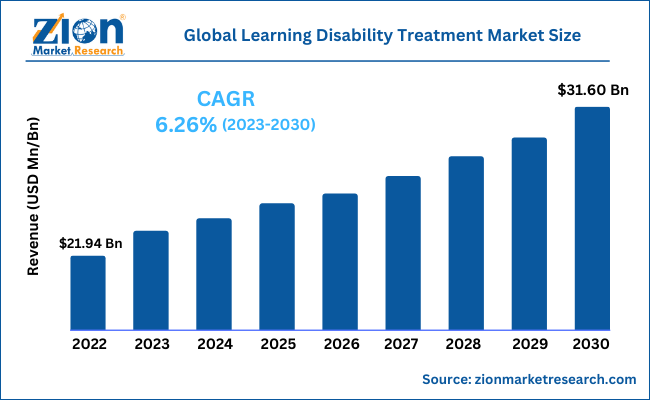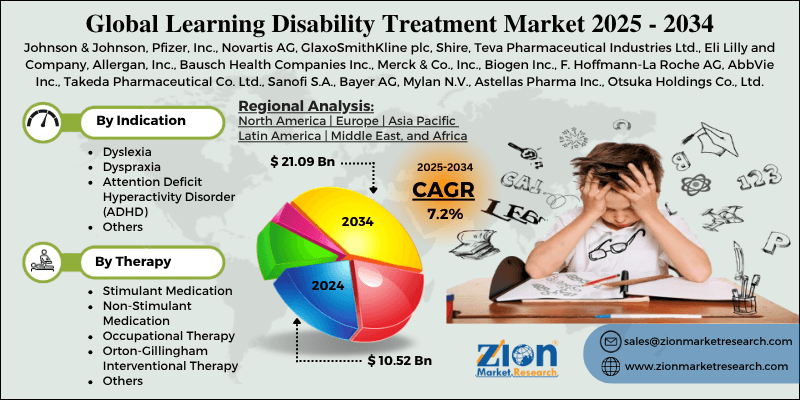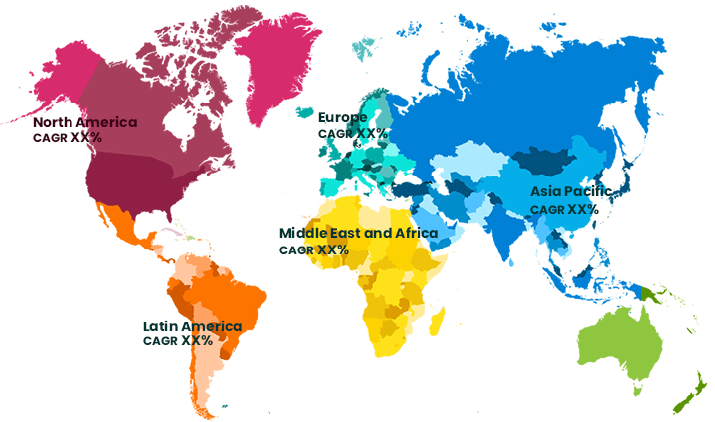Global Learning Disability Treatment Market Size, Share, Growth Analysis Report - Forecast 2034

Learning Disability Treatment Market By Therapy (Stimulant Medication, Non-Stimulant Medication, Occupational Therapy, Orton-Gillingham Interventional Therapy, Others), By Indication (Dyslexia, Dyspraxia, Attention Deficit Hyperactivity Disorder (ADHD), Others), and By Region: Global and Regional Industry Overview, Market Intelligence, Comprehensive Analysis, Historical Data, and Forecasts 2025 - 2034
| Market Size in 2024 | Market Forecast in 2034 | CAGR (in %) | Base Year |
|---|---|---|---|
| USD 10.52 Billion | USD 21.09 Billion | 7.2% | 2024 |
Learning Disability Treatment Market: Industry Perspective
The global learning disability treatment market size was worth around USD 10.52 Billion in 2024 and is predicted to grow to around USD 21.09 Billion by 2034 with a compound annual growth rate (CAGR) of roughly 7.2% between 2025 and 2034. The report analyzes the global learning disability treatment market's drivers, restraints/challenges, and the effect they have on the demands during the projection period. In addition, the report explores emerging opportunities in the learning disability treatment industry.
Learning Disability Treatment Market: Overview
A learning disability is a neurological disorder that affects the capacity of the brain to receive, send, and process information. A person with learning disabilities can have trouble speaking, writing, reading, listening, understanding mathematical concepts, and general understanding. Learning disorders include a category of conditions such as dyspraxia, dyslexia, dysgraphia, dyscalculia, and attention deficit hyperactivity disorder (ADHD). Each form of the disorder can co-exist with another.
Learning disabilities are not attributed to low intelligence. In reality, most people with learning disabilities are of average or above-average intelligence, but the influence of disability can affect their ability to perform well in school, at home, or at work.
According to research findings of the American Psychiatrist Association (APA), more than 50 percent of children with learning disorders will never recover from their disabilities. Successful early screening improves the patient’s quality of life with learning disabilities. Government agencies globally are offering sufficient financial resources for the development of new schools and clinics to benefit children and adults struggling with dyslexia, ADHD, dyspraxia, and other mental disabilities.
Key Insights
- As per the analysis shared by our research analyst, the global learning disability treatment market is estimated to grow annually at a CAGR of around 7.2% over the forecast period (2025-2034).
- Regarding revenue, the global learning disability treatment market size was valued at around USD 10.52 Billion in 2024 and is projected to reach USD 21.09 Billion by 2034.
- The learning disability treatment market is projected to grow at a significant rate due to Growing awareness and diagnosis of learning disabilities drive demand. Advances in therapeutic interventions and supportive technologies also support market growth.
- Based on Therapy, the Stimulant Medication segment is expected to lead the global market.
- On the basis of Indication, the Dyslexia segment is growing at a high rate and will continue to dominate the global market.
- Based on region, North America is predicted to dominate the global market during the forecast period.
Learning Disability Treatment Market: Growth Factors
Rise in healthcare expenditure and growing cases of learning disabilities among people drive the growth of the market
The global learning disability treatment market is driven by various factors, including the increasing prevalence of learning disabilities worldwide. Moreover, growing awareness and diagnosis rates for learning disabilities, availability of advanced treatment options, and supportive government initiatives are fueling the market growth. Rising investment in research and development activities, technological advancements in medical devices and drugs, and the development of innovative therapies for the treatment of learning disabilities are other driving factors.
Additionally, increasing healthcare expenditure and growing demand for personalized treatment options are expected to boost the market growth. Furthermore, the presence of major market players and their efforts toward developing new and effective treatments are also contributing to market expansion.
Learning Disability Treatment Market: Restraints
Extortionate cost of treatment and lack of awareness among people hinder the industry growth
Despite the growth prospects, the learning disability treatment industry faces some restraints such as a lack of awareness in developing economies, high treatment costs, and inadequate reimbursement policies. Moreover, stringent regulations related to drug approval and patient safety concerns may hinder market growth. Additionally, the COVID-19 pandemic has negatively impacted the market due to disruptions in the supply chain, reduced patient visits, and delayed clinical trials.
Learning Disability Treatment Market: Opportunities
Extensive use of advanced technologies such as virtual reality and artificial intelligence creates ample opportunities for the market
The learning disability treatment market presents several opportunities for growth in the future. Increasing focus on precision medicine and personalized treatment options is expected to create new opportunities for market players. The use of advanced technologies such as artificial intelligence and virtual reality for the development of innovative therapies also presents a potential opportunity for market growth. Furthermore, increasing research and development activities and collaborations among industry players and academic institutions can lead to the development of new and effective treatment options.
Additionally, the rising geriatric population and growing awareness about learning disabilities among parents and educators are expected to drive demand for learning disability treatment in the coming years. Moreover, the increasing availability of government funding for research & development in the healthcare sector and the growing focus on patient-centric care are also likely to create ample opportunities for the industry.
Learning Disability Treatment Market: Challenges
Complexity of learning disabilities and variability in symptoms among individuals act as a challenge for the industry
Some of the challenges faced by the learning disability treatment industry are the stigma associated with learning disabilities, which can lead to underdiagnosis and undertreatment. Furthermore, the complexity of learning disabilities and variability in symptoms among individuals pose significant challenges for developing effective treatments. Additionally, the lack of coordination and standardization in diagnosis and treatment practices across different healthcare settings can lead to suboptimal patient outcomes and may hinder market growth.
Learning Disability Treatment Market: Segmentation
The global learning disability treatment market is segmented based on therapy, indication, end-user, and region.
Based on Therapy, the market is bifurcated into Stimulant Medication, Non-Stimulant Medication, Occupational Therapy, Complimentary Therapy, and others. The stimulant medication segment held the largest market share in 2022 and is further predicted to grow rapidly at a significant CAGR during the forecast period. This is mainly due to the increasing prevalence of attention-deficit/hyperactivity disorder (ADHD), the effectiveness of stimulant medications in treating ADHD symptoms, and the growing awareness and acceptance of ADHD as a legitimate medical condition that requires treatment. Additionally, the ease of access to stimulant medications and the relatively low cost compared to other treatment options may also be contributing factors to the growth of this segment.
Based on Indication, the market is segmented into Dyslexia, Dyspraxia, Attention Deficit Hyperactivity Disorder (ADHD), and others. The dyslexia segment held the largest market share in 2022 and is further predicted to grow at an exponential CAGR during the forecast period. One of the main drivers is the increasing recognition and diagnosis of dyslexia, which has led to a growing demand for effective treatments. Additionally, advances in neuroscience and educational research have led to the development of new and improved interventions for dyslexia, including evidence-based reading programs, multisensory teaching methods, and assistive technologies.
Furthermore, changes in legislation and educational policies in some countries have mandated greater support for students with dyslexia, leading to increased investment in educational interventions and accommodations. Moreover, growing awareness and understanding of the impact of dyslexia on individuals and society as a whole, have led to greater advocacy and support from organizations, governments, and other stakeholders, driving innovation and investment in the dyslexia segment.
Based on End-User, the market is segmented into hospitals and clinics segment. The clinic segment is predicted to grow rapidly at a significant CAGR during the forecast period.
Recent Developments
- In 2020, the pharmaceutical company, Takeda, received approval from the FDA for a new ADHD medication called Trintellix. Trintellix is a selective serotonin reuptake inhibitor (SSRI) that has shown promise in reducing symptoms of ADHD in clinical trials. This approval represents a significant development in the ADHD treatment market, providing patients with a new option for managing their symptoms.
- In 2019, the educational technology company, Amplify, launched a new reading program called mCLASS® with DIBELS® 8th Edition. This program uses technology to provide real-time feedback and assessments to help students improve their reading skills. This development represents a significant advancement in the use of technology to support learning disabilities and has the potential to improve outcomes for students with dyslexia and other reading disabilities.
Learning Disability Treatment Market: Report Scope
| Report Attributes | Report Details |
|---|---|
| Report Name | Learning Disability Treatment Market |
| Market Size in 2024 | USD 10.52 Billion |
| Market Forecast in 2034 | USD 21.09 Billion |
| Growth Rate | CAGR of 7.2% |
| Number of Pages | 214 |
| Key Companies Covered | Johnson & Johnson, Pfizer, Inc., Novartis AG, GlaxoSmithKline plc, Shire, Teva Pharmaceutical Industries Ltd., Eli Lilly and Company, Allergan, Inc., Bausch Health Companies Inc., Merck & Co., Inc., Biogen Inc., F. Hoffmann-La Roche AG, AbbVie Inc., Takeda Pharmaceutical Co. Ltd., Sanofi S.A., Bayer AG, Mylan N.V., Astellas Pharma Inc., Otsuka Holdings Co., Ltd., and AstraZeneca., and others. |
| Segments Covered | By Therapy, By Indication, and By Region |
| Regions Covered | North America, Europe, Asia Pacific (APAC), Latin America, The Middle East and Africa (MEA) |
| Base Year | 2024 |
| Historical Year | 2020 to 2023 |
| Forecast Year | 2025 - 2034 |
| Customization Scope | Avail customized purchase options to meet your exact research needs. Request For Customization |
Learning Disability Treatment Market: Regional Analysis
North America region is predicted to dominate the global market during the forecast period
Based on region, the North American region held the largest learning disability treatment market share in 2022 and is further predicted to grow at a remarkable CAGR during the forecast period. Several factors have contributed to the growth of the learning disability treatment market in North America. One of the main drivers is the increasing prevalence of learning disabilities in the region, which has led to a growing demand for effective treatments. Additionally, advances in medical research and technology have led to the development of new and innovative therapies and medications for learning disabilities.
Moreover, changes in education policies and legislation have mandated greater support and accommodations for students with learning disabilities, driving investment in educational interventions and specialized services. In addition, the increasing adoption of telemedicine and digital health technologies has improved access to learning disability treatments and services, particularly in rural and underserved areas.
Learning Disability Treatment Market: Competitive Analysis
The report provides a company market share analysis to give a broader overview of the key market players. In addition, the report also covers key strategic developments of the market, including acquisitions & mergers, new product launches, agreements, partnerships, collaborations & joint ventures, research & development, and regional expansion of major participants involved in the learning disability treatment market on a global and regional basis.
The global learning disability treatment market is dominated by players like:
- Johnson & Johnson
- Pfizer Inc.
- Novartis AG
- GlaxoSmithKline plc
- Shire
- Teva Pharmaceutical Industries Ltd.
- Eli Lilly and Company
- Allergan Inc.
- Bausch Health Companies Inc.
- Merck & Co. Inc.
- Biogen Inc.
- F. Hoffmann-La Roche AG
- AbbVie Inc.
- Takeda Pharmaceutical Co. Ltd.
- Sanofi S.A.
- Bayer AG
- Mylan N.V.
- Astellas Pharma Inc.
- Otsuka Holdings Co. Ltd.
- and AstraZeneca.
The global learning disability treatment market is segmented as follows;
By Therapy
- Stimulant Medication
- Non-Stimulant Medication
- Occupational Therapy
- Orton-Gillingham Interventional Therapy
- Others
By Indication
- Dyslexia
- Dyspraxia
- Attention Deficit Hyperactivity Disorder (ADHD)
- Others
By Region
- North America
- The U.S.
- Canada
- Mexico
- Europe
- France
- The UK
- Spain
- Germany
- Italy
- Rest of Europe
- Asia Pacific
- China
- Japan
- India
- Australia
- South Korea
- Rest of Asia Pacific
- The Middle East & Africa
- Saudi Arabia
- UAE
- Egypt
- Kuwait
- South Africa
- Rest of the Middle East & Africa
- Latin America
- Brazil
- Argentina
- Rest of Latin America
Table Of Content
Methodology
FrequentlyAsked Questions
learning disability is a neurological disorder that affects the capacity of the brain to receive, send, and process information. A person with learning disabilities can have trouble speaking, writing, reading, listening, understanding mathematical concepts, and general understanding. Learning disorders include a category of conditions such as dyspraxia, dyslexia, dysgraphia, dyscalculia, and attention deficit hyperactivity disorder (ADHD). Each form of the disorder can co-exist with another.
The global learning disability treatment market is expected to grow due to Growing awareness and diagnosis of learning disabilities drive demand. Advances in therapeutic interventions and supportive technologies also support market growth.
According to a study, the global learning disability treatment market size was worth around USD 10.52 Billion in 2024 and is expected to reach USD 21.09 Billion by 2034.
The global learning disability treatment market is expected to grow at a CAGR of 7.2% during the forecast period.
North America is expected to dominate the learning disability treatment market over the forecast period.
Leading players in the global learning disability treatment market include Johnson & Johnson, Pfizer, Inc., Novartis AG, GlaxoSmithKline plc, Shire, Teva Pharmaceutical Industries Ltd., Eli Lilly and Company, Allergan, Inc., Bausch Health Companies Inc., Merck & Co., Inc., Biogen Inc., F. Hoffmann-La Roche AG, AbbVie Inc., Takeda Pharmaceutical Co. Ltd., Sanofi S.A., Bayer AG, Mylan N.V., Astellas Pharma Inc., Otsuka Holdings Co., Ltd., and AstraZeneca., among others.
The report explores crucial aspects of the learning disability treatment market, including a detailed discussion of existing growth factors and restraints, while also examining future growth opportunities and challenges that impact the market.
RelatedNews
HappyClients
Zion Market Research
Tel: +1 (302) 444-0166
USA/Canada Toll Free No.+1 (855) 465-4651
3rd Floor,
Mrunal Paradise, Opp Maharaja Hotel,
Pimple Gurav, Pune 411061,
Maharashtra, India
Phone No +91 7768 006 007, +91 7768 006 008
US OFFICE NO +1 (302) 444-0166
US/CAN TOLL FREE +1 (855) 465-4651
Email: sales@zionmarketresearch.com
We have secured system to process your transaction.
Our support available to help you 24 hours a day, five days a week.
Monday - Friday: 9AM - 6PM
Saturday - Sunday: Closed







